Yellampalli S. (ed.) Carbon Nanotubes - Synthesis, Characterization, Applications
Подождите немного. Документ загружается.


Study of Carbon Nanotubes Based on Higher Order Cauchy-Born Rule
227
33
ˆ
11
1
ˆ
ˆˆ ˆ
[(()( )](
4
IJIK IJ IK IK
I
JK
V
FG
ηη
MKRη R η R η (24b)
33
ˆ
11
1
ˆ
ˆˆ ˆ
[(()())]( )
4
IJIK IJ IJ IK
I
JK
V
GF
MKRη R η R η (24c)
33
ˆ
11
1
ˆ
ˆˆ ˆ ˆ
[ (( ) ( ))] (( ) ( ))
8
IJIK IJ IJ IK IK
I
JK
V
GG
MKRη R η R η R η (24d)
2
ˆ
ˆ
,
ˆ
IJ IJ
IJIK
IJ IJ
W
rr
K
rr
(25)
ˆˆ ˆˆ
():[()()]2
IJ IJ IJ IJ
rFRη GR η R η (26)
2
33
0
ˆ
11
2
1
ˆ
ˆ
[(( )( )
2
ˆ
ˆ
ˆˆ
( (( ) ( )))) ]
IJIK IJ
I
JK
IJIK IK IJ IJ
W
V
sym
KFRη
F η
KGRη R η f1
(27)
3
0
ˆ
1
1
ˆ
ˆ
[ ( ( ))]
2
IJ IJ
I
J
W
sym
V
fF GRη
η
(28)
2
33
0
ˆ
11
2
1
ˆ
[ (( ( ( )))
2
ˆ
ˆ
ˆ
(())) ]
IJ
I
JK
IJIK IK IJ
W
sym
V
T
FGRη
η F
KRη f1
(29)
2
33
0
ˆ
11
1
ˆ
ˆ
[ ( ( ( )))
2
ˆ
ˆ
( ( ( )))) ]
IJ IJIK
I
JK
IK IJ
W
sym
V
sym sym
T
FGRη K
ηη
FGRη fG
(30)
2
33
0
ˆ
11
2
2
1
ˆ
ˆˆˆ
[(( (( )()()))
4
ˆ
ˆ
ˆˆ ˆ
()()())(())
ˆ
ˆ
(( ))]
IJIK IK IJ IJ
I
JK
IJIK IK IK IJ IJ
IJ IJ
W
sym
V
KGRη R η R η
G η
KFRη R η fRη 1
fRη 1
(31)

Carbon Nanotubes - Synthesis, Characterization, Applications
228
2
33
0
ˆ
11
2
11
ˆ
[ ( (( ( ( )))
22
ˆ
ˆ
ˆˆ ˆ
( ( ) ( )))) ( ( ))]
IJ
I
JK
IJIK IK IK IJ IJ
W
sym
V
sym
T
FGRη
η G
KRη R η f1Rη
(32)
where
2
1 is the second order identity tensor. The symbols used in the above expressions are
defined as:
( [ ( )]) ( ) /2
ijk ip pkn n j ip pqk q j
sym A B c d A B c d
AB c d
(33)
()
i
j
kik
j
A
b
Ab
(34)
[( )]( )/2
ij ijr r irj r
sym B b B b
Bb
(35)
()
i
j
k
j
ik
aA
aA (36)
()( )/2
ijk ijk ikj
sym G G
G
(37)
[( ) ]
i
j
kl i k
j
l
ab A ab A (38)
( [ ( )]) ( ) /2
ijkl ip plr r j k ip pql q j k
sym A B c d d A B c d d
AB c d d
(39)
()
i
j
kl il
j
k
A
cc
Acc
(40)
(( )) ( )/2
ijkl j ik l j il k
sym a A b a A b
aAb
(41)
5. Mechanical properties of SWCNTs
It is usually thought that SWCNTs can be formed by rolling a graphite sheet into a hollow
cylinder. To predict mechanical properties of SWCNTs, a planar graphite sheet in
equilibrium energy state is here defined as the undeformed configuration, and the current
configuration of the nanotube can be seen as deformed from the initial configuration by the
following mapping:
111
2
220 11
0
2
320 11
0
sin( )
(cos( ) 1)
xX
X
xR X
R
X
xR X
R
(42)
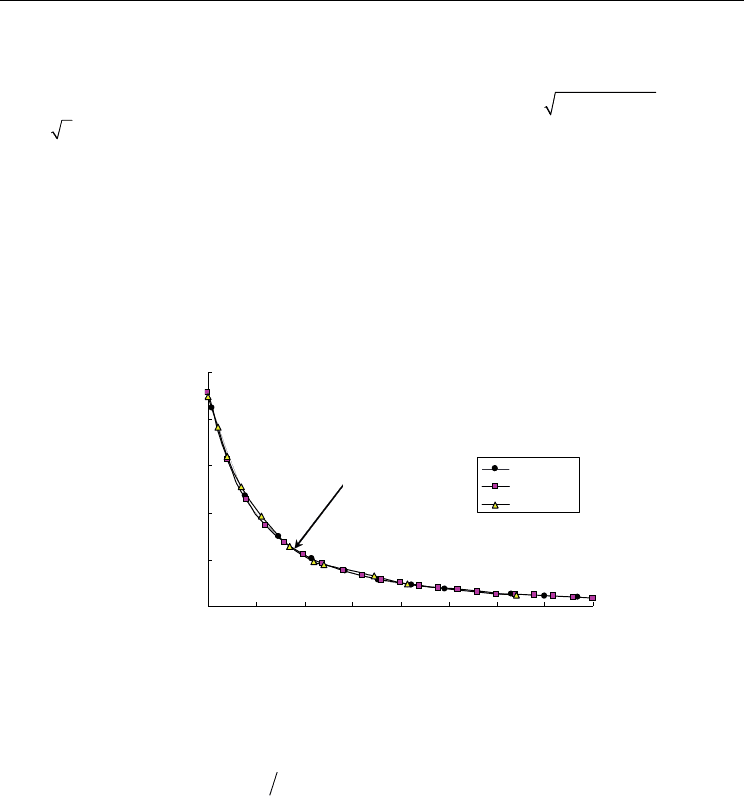
Study of Carbon Nanotubes Based on Higher Order Cauchy-Born Rule
229
where ,1,2
i
Xi is Lagrange coordinate associated with the undeformed configuration
(here is a graphite sheet) and
, 1,2,3
i
xi
is Eulerian coordinate associated with the
deformed configuration.
R is the radius of the modeled SWCNT, which is described by a
pair of parameters
(, )nm . The radius R can be evaluated by
22
/2Ram mnn
π
with
0
3aa , where
0
a is the equilibrium bond length of the atoms in the graphite sheet.
represents the rotation angle per unit length, and parameters
1
and
2
control the
uniform axial and circumferential stretch deformation, respectively.
5.1 The energy per atom for graphene sheet and SWCNTs
First, based on the present model, the energy per atom of the graphite sheet is calculated
and the value of -1.1801
22
/Kg nm s is obtained. It can be found that the present value
agrees well with that of -7.3756 eV (
19
11.610eV Nm
) given by Robertson et al. (1992)
with the use of the same interatomic potential.
0.00
0.01
0.02
0.03
0.04
0.05
0.40 0.60 0.80 1.00 1.20 1.40 1.60 1.80 2.00
Tube Diameter(nm)
Energy(Kg*nm2/s2/atom)
armchair
zigzag
Robertson
~1/D
2
Fig. 4. The energy (relative to graphite) per atom versus tube diameter
The energy per atom as the function of diameters for armchair and zigzag SWNTs relative to
that of the graphene sheet is shown in Figure 4. The trend is almost the same for both
armchair and zigzag SWNTs. The energy per atom decreases with increase of the tube
diameter with
2
() () (1 )ED E O D
, where
()E
represents the energy per atom for
graphite sheet.
For larger tube diameter, the energy per atom approaches that of graphite. On the whole, it
can be shown that the energy per atom depends obviously on tube diameters, but does not
depend on tube chirality. For comparison, the results obtained by Robertson et al. (1992)
with the use of both empirical potential and first-principle method based on the same
interatomic potential are also shown in Figure 4. It can be found the present results are not
only in good agreement with Robertson’s results, but also with those obtained by Jiang et al.
(2003) based on incorporating the interatomic potential (Tersoff-Brenner potential) into the
continuum analysis.
Figure 5 shows the energy per atom for different chiral SWCNTs ((2n, n), (3n, n), (4n, n), (5n,
n) and (8n, n)) as a function of tube radius relative to that of the graphene sheet. As is
expected, the energy per atom of chiral SWCNTs decreases with increasing tube radius and
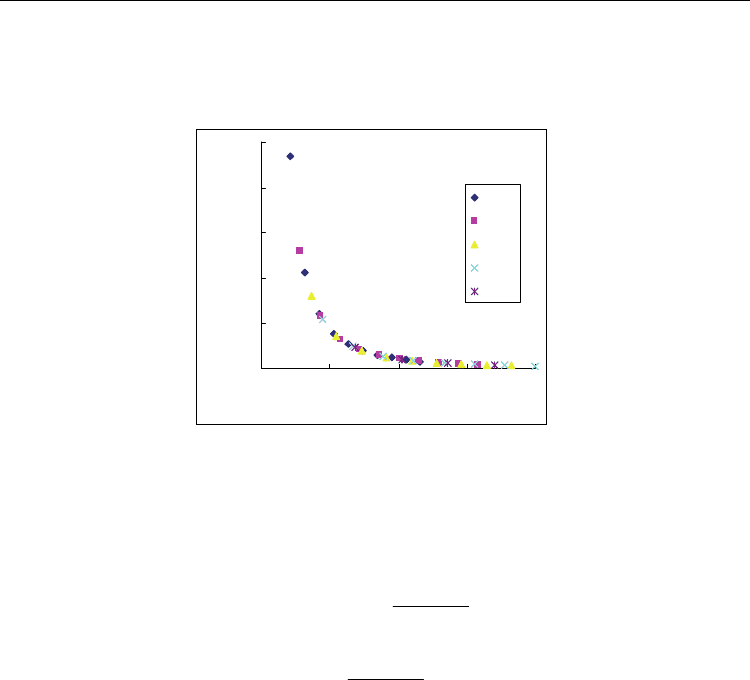
Carbon Nanotubes - Synthesis, Characterization, Applications
230
the limit value of this quantity is -7.3756 eV when the radius of tube is large. From Figure 5,
it can be clearly found again that the strain energy per atom depends only on the radius of
the tube and is independent of the chirality of SWCNTs, which is similar to armchair and
zigzag SWCNTs.
0.00
0.05
0.10
0.15
0.20
0.25
0.0 0.5 1.0 1.5 2.0
Tube radius(nm)
Energy(eV/atom
)
(2n,n)
(3n,n)
(4n,n)
(5n,n)
(8n,n)
Fig. 5. The strain energy relative to graphite (eV/atom) as a function of tube radius.
5.2 Young’s modulus and Poisson ratio for graphene sheet and SWCNTs
As shown by Zhang et al. (2002c), the Young’s modulus and the Poisson’s ratio of planar
graphite can be defined from
ˆ
FF
M
by the following expressions:
1122
2
1111
2222
ˆ
()
ˆ
()
ˆ
()
FF
FF
FF
E
M
M
M
(43)
1122
1111
ˆ
()
ˆ
()
FF
FF
v
M
M
(44)
For SWCNTs, we also use the above expressions to estimate their mechanical properties
along the axial direction although the corresponding elasticity tensors are no longer
isotropic as in planar graphite case. Note that all calculations performed here are based on
the Cartesian coordinate system and the Young’s modulus
E is obtained by dividing the
thickness of the wall of SWNT, which is often taken as 0.334nm in the literature.
As for the graphite, the resulting Young’s modulus is 0.69TP (see the dashed line in Figure
6a), which agrees well with that suggested by Zhang et al (2002c) and Arroyo and
Belytschko (2004b) based on the same interatomic potential (represents by the horizontal
solid line in Figure 6a). The Poisson’s ratio predicted by the present approach is 0.4295 (see
the dashed line shown in Figure 6c), which is also very close to the value of 0.4123 given by
Arroyo and Belytschko (2004b) using the same interatomic potential.
As for armchair and zigzag SWCNTs, Figure 6a displays the variations of the Young’s
modulus with different diameters and chiralities. It can be observed that the trend is similar
for both armchair and zigzag SWNTs and the influence of nanotube chirality is not significant.
For smaller tubes whose diameters are less than 1.3 nm, the Young’s modulus strongly
depends on the tube diameter. However, for tubes diameters larger than 1.3 nm, the

Study of Carbon Nanotubes Based on Higher Order Cauchy-Born Rule
231
dependence becomes very weak. As a whole, it can be seen that for both armchair and zigzag
SWNTs the Young’s modulus increases with increase of tube diameter and a plateau is
reached when the diameter is large, which corresponds to the modulus of graphite predicted
by the present method. The existing non-orthogonal tight binding results given by Hernández
et al.(1998), lattice-dynamics results given by Popov et al. (2000) and the exponential Cauchy-
Born rule based results given by Arroyo and Belytschko (2002b) are also shown in Figure 6a
for comparison. Comparing with the results given by Hernández et al. (1998) and Popov et al.
(2000), it can be seen that although their data are larger than the corresponding ones of the
present model, the general tendencies predicted by different methods are in good agreement.
From the trend to view, the present predicted trend is also in reasonable agreement with that
given by Robertson et al. (1992), Arroyo and Belytschko (2002b), Chang and Gao (2003) and
Jiang et al. (2003). As for the differences between the values of different methods, it may be
due to the fact that different parameters and atomic potential are used in different theories or
algorithms (Chang and Gao, 2003). For example, Yakobson’s (1996) result of surface Young’s
modulus of carbon nanotube based on molecular dynamics simulation with Tersoff-Brenner
potential is about 0.36TPa nm, while Overney’s (1993) result based on Keating potential is
about 0.51 TP nm. Recent ab initio calculations by Sánchez-Portal et al.(1999) and Van Lier et al.
(2000) showed that Young’s modulus of SWNTs may vary from 0.33 to 0.37TPa nm and from
0.24 to 0.40 TPa nm, respectively. Furthermore, it can be found that our computational results
agree well with that given by Arroyo and Belytschko (2002b) with their exponential Cauchy-
Born rule. They are also in reasonable agreement with the experimental results of 0.8 0.4 TP
given by Salveta et al. (1999).
Figure 6b depicts the size-dependent Young’s moduli of different chiral SWCNTs ((2n, n),
(3n, n), (4n, n), (5n, n) and (8n, n)). It can be seen that Young’s moduli for different chiral
SWCNTs increase with increasing tube radius and approach the limit value of graphite
when the tube radius is large. For a given tube radius, the effect of tube chirality can almost
be ignored. The Young’s modulus of different chiral SWCNTs are consistent in trends with
those for armchair and zigzag SWCNTs. For chiral SWCNTs, the trends of the present
results are also in accordance with those given by other methods, including lattice dynamics
(Popov et al., 2000) and the analytical molecular mechanics approach (Chang & Gao, 2003) .
From Figure 6c, the effect of tube diameter on the Poisson’s ratio is also clearly observed. It
can be seen that, for both armchair and zigzag SWNTs, the Poisson’s ratio is very sensitive
to the tube diameters especially when the diameter is less than 1.3 nm. The Poisson’s ratio of
armchair nanotube decreases with increasing tube diameter but the situation is opposite for
that of the zigzag one. However, as the tube diameters are larger than 1.3 nm, the Poisson’s
ratio of both armchair and zigzag SWNTs reach a limit value i.e. the Poisson’s ratio of the
planar graphite. For comparison, the corresponding results suggested by Popov et al. (2000)
are also shown in Figure 6c. It can be observed that the tendencies are very similar between
the results given by Popov et al. (2000) and the present method although the values are
different. Moreover, it is worth noting although many investigations on the Poisson’s ratio
of SWNTs have been conducted, there is no unique opinion that is widely accepted. For
instance, Goze et al. (1999) showed that the Poisson’s ratio of (10,0), (20,0), (10,0) and (20,0)
tubes are 0.275, 0.270, 0.247 and 0.256, respectively. Based on a molecular mechanics
approach, Chang and Gao (2003) suggested that the Poisson’s ratio for armchair and zigzag
SWNTs will decrease with increase of tube diameters from 0.19 to 0.16, and 0.26 to 0.16,
respectively. In recent ab initio studies of Van Lier et al. (2000), even negative Poisson’s ratio
is reported.
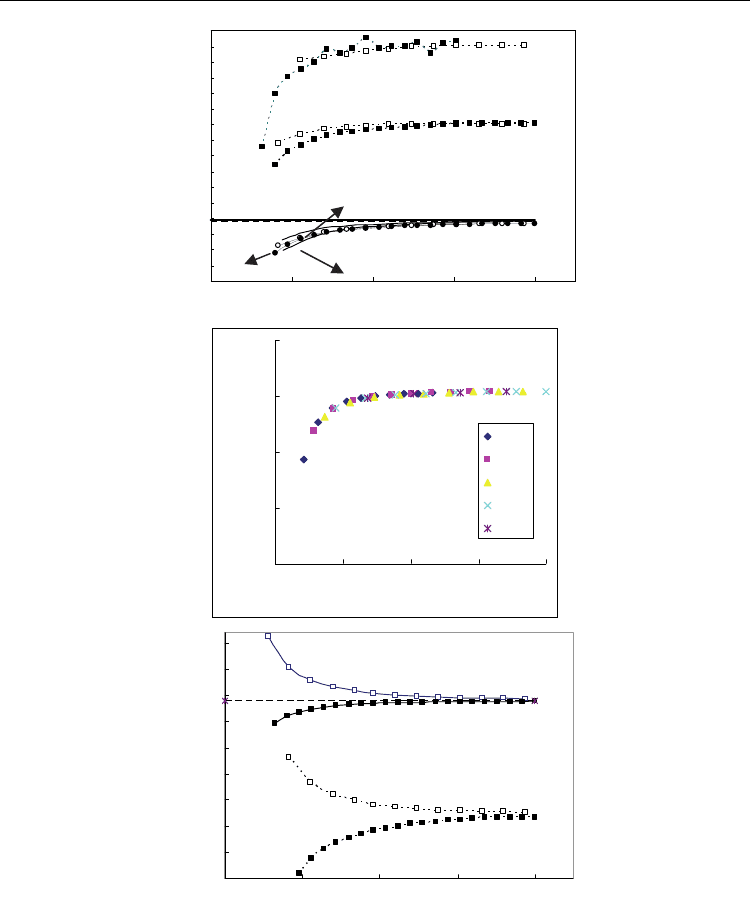
Carbon Nanotubes - Synthesis, Characterization, Applications
232
0.50
0.55
0.60
0.65
0.70
0.75
0.80
0.85
0.90
0.95
1.00
1.05
1.10
1.15
1.20
1.25
1.30
0.00 0.50 1.00 1.50 2.00
Tube Diameter(nm)
Young's Modulus(TPa)
0.55
0.60
0.65
0.70
0.75
0.00.51.01.52.0
Tube radius(nm)
Young's modulus(TPa)
(2n,n)
(3n,n)
(4n,n)
(5n,n)
(8n,n)
0.09
0.14
0.19
0.24
0.29
0.34
0.39
0.44
0.49
0.54
0.00 0.50 1.00 1.50 2.00
Tube Diameter(nm)
Poisson Ratio
Fig. 6. Comparison between the results obtained with different methods (a) Young’s
modulus and (b) Young’s moduli of chiral SWCNTs versus tube radius. (c)Poisson’s ratio.
Open symbols denote armchair, solid symbols denote zigzag. Dashed horizontal line
denotes the results of graphite obtained with the present approach and the solid horizontal
line denotes the results of graphite obtained by Arroyo and Belytschko (2004b) with
exponential mapping, respectively.
Popov
Present
Po
p
ov
Hernández
Presen
Arroyo
Arroyo
(a)
(b)
(c)
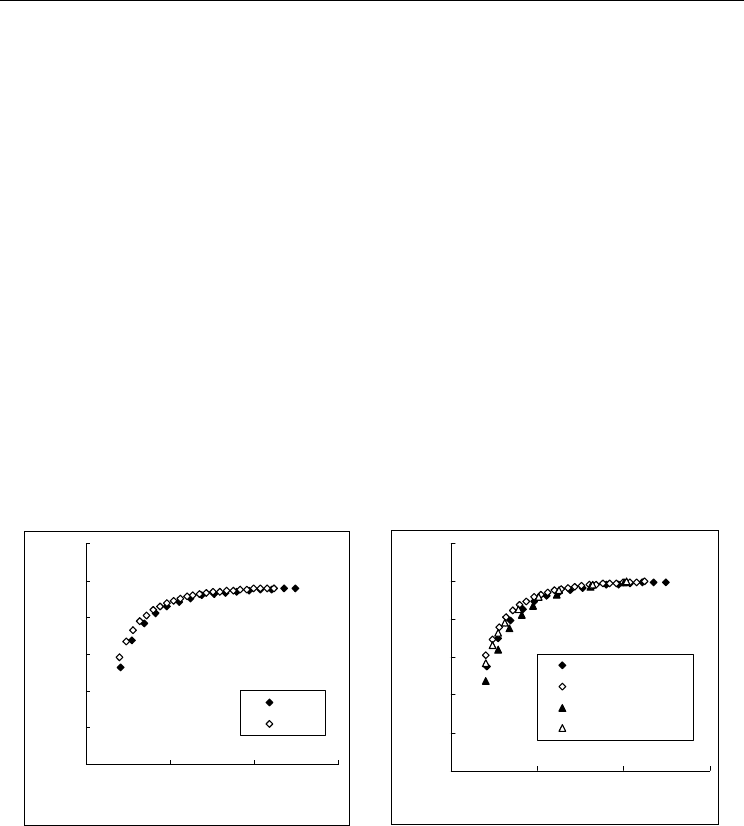
Study of Carbon Nanotubes Based on Higher Order Cauchy-Born Rule
233
It also can be seen from Figure 6c that the obtained Poisson’s ratio is a little bit high when
tube diameter is less than 0.3nm. It may be ascribed to the fact that when tube diameter is
less than 0.3nm, because of the higher value of curvature, higher order (
2 ) deformation
gradient tensor should be taken into account in order to describe the deformation of the
atomic bonds more accurately. Another possible explanation is that for such small values of
diameter, more accurate interatomic potential should be used in this extreme case.
5.3 Shear modulus for SWCNTs
As for the shear moduli of SWCNTs, to the best of our knowledge, only few works studied
this mechanical property systematically since it is difficult to measure them with experiment
techniques. Most of these works focus only on the armchair and zigzag SWCNTs.(Popov et
al., 2000; Li & Chou, 2003) Thus, the shear moduli of achiral (i.e., armchair and zigzag)
SWCNTs are firstly investigated and compared with the existing results
(Li & Chou, 2003)
for validation of the present model. Then the shear modulus of SWCNTs with different
chiralities including (2n, n), (3n, n), (4n, n), (5n, n) and (8n, n) are studied systematically. For
determining the shear modulus of SWCNT, it is essential to simulate its pure torsion
deformation which can be implemented by incrementally controlling
but relaxing inner
displacement η , parameters
1
and
2
in Equation (42). The shear modulus of SWCNTs
can be obtained by the U (strain energy density) and
(twist angle per unit length). Similar
to Young’s modulus, shear modulus is defined with respect to the initial stress free state.
0.00
0.05
0.10
0.15
0.20
0.25
0.30
0.0 0.5 1.0 1.5
Tube Radius(nm)
Shear Moudulus(TPa)
(n,n)
(n,0)
0.0
0.2
0.4
0.6
0.8
1.0
1.2
00.511.5
Tube Radius(nm)
Normalized Shear Modul
(n,n)(present)
(n,0)(present)
(n,n)(Li et al.2003)
(n,0)(Li et al.2003)
(a) (b)
Fig. 7. (a) Shear moduli of armchair and zigzag SWCNTs versus tube radius, (b) Effect of
tube radius on normalized shear moduli of armchair and zigzag SWCNTs.
Figure 7a shows the variations of the shear modulus of achiral SWCNTs with respect to the
tube radius. It can be found that shear modulus of armchair and zigzag SWCNTs increase
with increasing tube radius and approach the limit value 0.24 TPa when the tube radius is
large. It is also observed that, similar to the results given by Li
& Chou (2003) and Xiao et al.
(2005), the present predicted shear moduli of armchair and zigzag SWCNTs hold similar
size-dependent trends and the chirality-dependence of shear moduli is not significant.
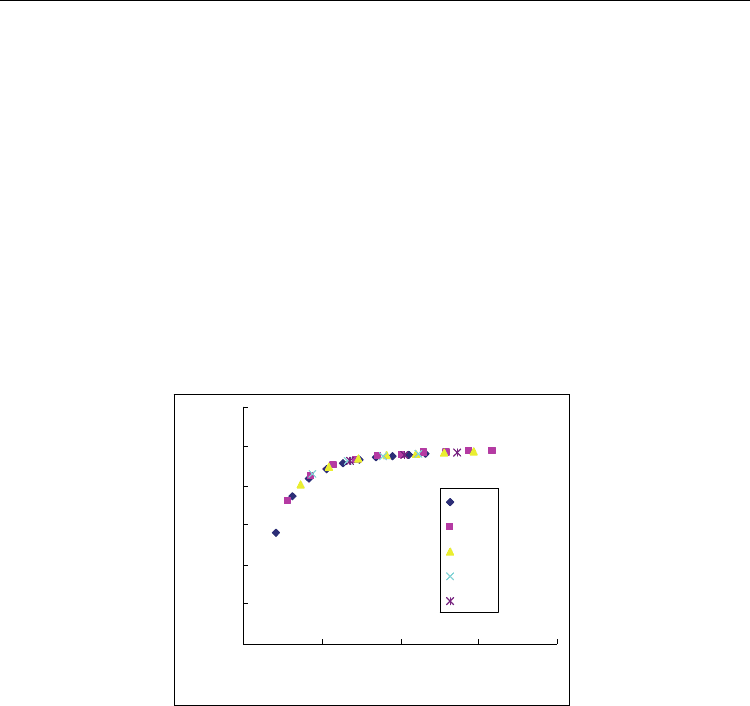
Carbon Nanotubes - Synthesis, Characterization, Applications
234
Figure 7b shows the normalized shear moduli obtained with different methods. The
normalization is achieved by using the values of 0.24 TPa and 0.48 TPa which are the
limiting values of graphite sheet obtained by the present approach and molecular structural
mechanics
(Li
& Chou, 2003), respectively. Although there is a discrepancy in limit values, it
can be found that the size effect obtained by the present study is in good agreement with
that of Li and Chou (2003). The difference among the limit values may be attributed to the
different atomistic potential and/or force field parameters used in the computation model.
The size-dependent shear modulus of different chiralities SWCNTs are displayed in Figure
8. It is observed that, similar to achiral SWCNTs, the shear moduli of chiral SWCNTs
increase with increasing tube radius and a limit value of 0.24 TPa is approaching when the
tube radius (also n) is large. For (2n, n) SWCNT, the maximum difference of shear modulus
is up to 42%. The dependence of tube chirality is not obvious for chiral SWCNTs. With
reference to Figure 7a and Figure 8, it can be found that, at small radius (<1nm), the shear
modulus of SWCNTs are sensitive to the tube radius, while at larger radius (>1nm), the size
and chirality dependency can be ignored.
0.00
0.05
0.10
0.15
0.20
0.25
0.30
0.0 0.5 1.0 1.5 2.0
Tube radius(nm)
Shear modulus(TPa)
(2n,n)
(3n,n)
(4n,n)
(5n,n)
(8n,n)
Fig. 8. Shear moduli of chiral SWCNTs versus tube radius.
5.4 Bending stiffness for graphene sheet and SWCNTs
In present study, the so-called bending stiffness for graphene sheet refers to the resistance of
a flat graphite sheet or the curved wall of CNT with respect to the infinitesimal local
bending deformation. The bending stiffness for SWCNTs refers to the bending resistance of
the cylindrical tube formed by rolling up graphite sheet with respect to the infinitesimal
global bending deformation (see Figure 9 for reference). It should be pointed out that for the
first definition, the bending stiffness is an intrinsic material property solely determined by
the atomistic structure of the mono-layer crystalline membrane. The second definition,
however, is a structural property which is determined not only by the bending stiffness of the
single atom layer crystalline membrane, but also by the geometry dimensions, such as the
diameter of the tube. Unfortunately, these two issues are not well addressed in the past
literatures (Kudin et at., 2001; Enomoto et al., 2006).
Based on the higher order Cauchy-Born rule and Equation (42), the strain energy per atom
(energy relative to a planar graphite sheet) as a function of the radius of bending curvature can
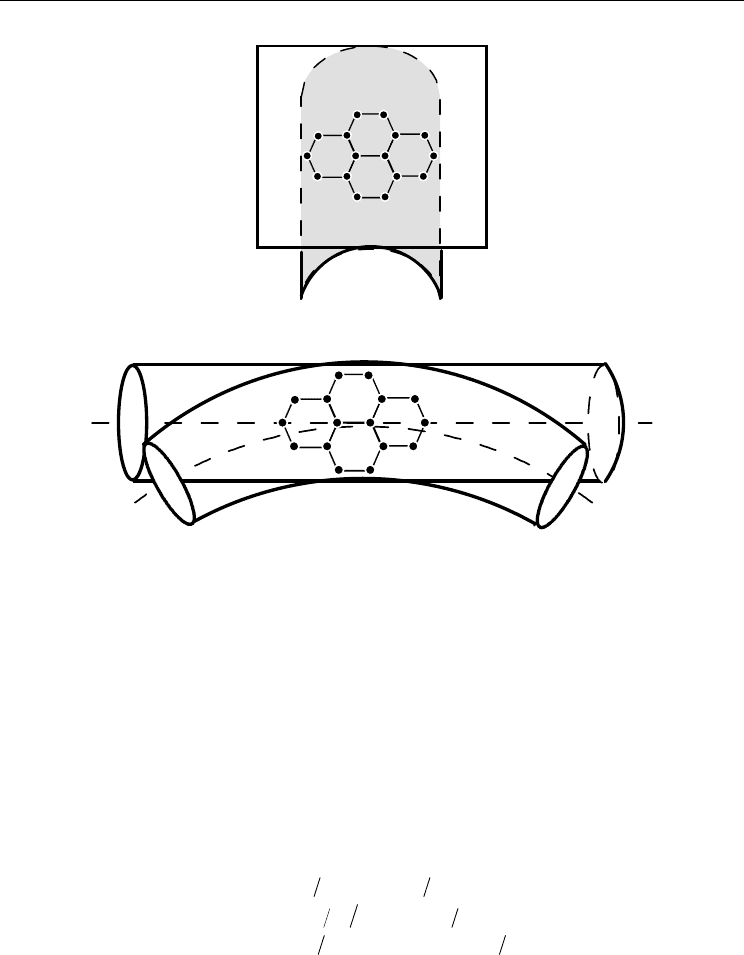
Study of Carbon Nanotubes Based on Higher Order Cauchy-Born Rule
235
(a)
(b)
Fig. 9. (a) Bending of a flat graphite sheet; (b) Bending of a single-walled carbon nanotube
be obtained. By fitting the data of the strain energy and the bending curvature radii with
respect to the equation
2
0
/2
membrane
UD R , one can obtain that the bending stiffness
membrane
D
of the graphite sheet is 2.38 eVÅ
2
/atom, which is almost independent of its rolling direction.
This indicates that the flat graphite sheet is nearly isotropic with regard to bending. The
current result agrees well with the effective bending stiffness of graphite sheet 2.20 eVÅ
2
/atom
reported by Arroyo and Belytschko (2004a) with membrane theory and the same interatomic
potential under the condition of infinitesimal bending. It is also in good agreement with the
result of 2.32 eVÅ
2
/atom obtained by Robertson et al. (1992)
with atomic simulations.
To explore the effective bending stiffness of carbon nanotube based on the higher order
Cauchy-Born rule, the following map is used to describe the pure bending deformation of
the tube
11 2
2
21 2
32 1
sin( ) sin( )sin
sin ( ) 2 sin( )cos
cos( ) ( arctan( ))
xXRXR
xXRXR
xR XR X
(45)
where
R is the radius of the modeled SWCNT and
is the radius of curvature of the
bending tube (curvature of the neutral axis). With the use of this mapping and taking the
inner-displacement relaxation into consideration, the strain energy of the bending tube can
be computed.
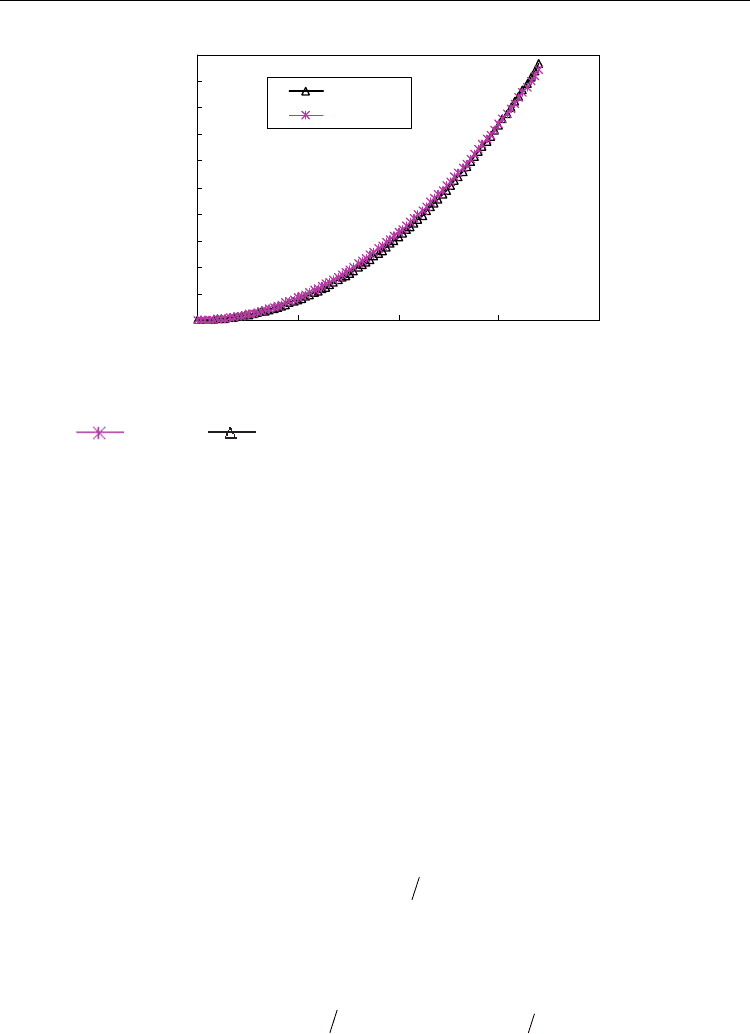
Carbon Nanotubes - Synthesis, Characterization, Applications
236
0.0
0.2
0.4
0.6
0.8
1.0
1.2
1.4
1.6
1.8
2.0
0 5 10 15 20
Bending Angle(deg)
Strain Energy(eV
)
(10,0)MD
(10,0)HCB
Fig. 10. Comparison of the strain energy of (10,0) SWCNT as a function of the bending angle
for HCB(
) and MD( ) simulation. Herein and after, HCB refers to the continuum
theory based on a higher-order Cauchy-Born rule and MD refers to molecular dynamics
Figure 10 show the bending strain energy of zigzag (10,0) SWCNT as a function of bending
angle. Here the bending strain energy is defined as the difference between the energy of the
deformed tube and that of its straight status. It can be found that the present results
obtained with much less computational effort are in good agreement with those of MD
simulations.
where
L denotes the length of the tube. It can be seen clearly from Equation (46) that the
effective bending stiffness of CNTs can be defined as the second derivative of the elastic
energy per unit length with respect to the curvature of the neutral axis under pure bending
(i.e. constant curvature). Its dimension is eV nm
. Figure 11 shows the bending stiffness of
different chiral SWCNTs as a function of the tube radius. It can be found that the bending
stiffness is almost independent on the chirality of SWCNTs and increases with the
increasing of tube radius. Furthermore, using a polynomial fitting procedure, we can
approximate the bending stiffness over the considered range of tube radii by the following
analytical expression
Once the bending strain energy U is known, the effective bending stiffness of carbon
nanotube can be obtained by numerical differentiation based on the following formula
2
2
tube
UDL
(46)
Just like the derivation of the bending stiffness of the flat graphite sheet, here no
representative thickness of the tube is required to obtain the effective bending stiffness of
CNTs.
23 3 2 2
( ) 5583.956( ) ( ) 9.225( ) ( )
32.418( ) ( ) 1.517( )
tube
DeVnm eVnmRnm eVnmRnm
eV R nm eV nm
(47)
